Barn doors: types and features
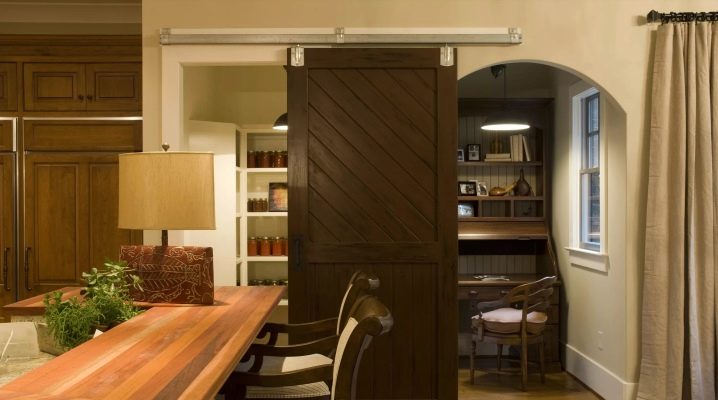
By no means in all cases the doors must have a complex structure. Sometimes it is appropriate to use very simple, but therefore no less functional and elegant solutions. Such as barn doors.
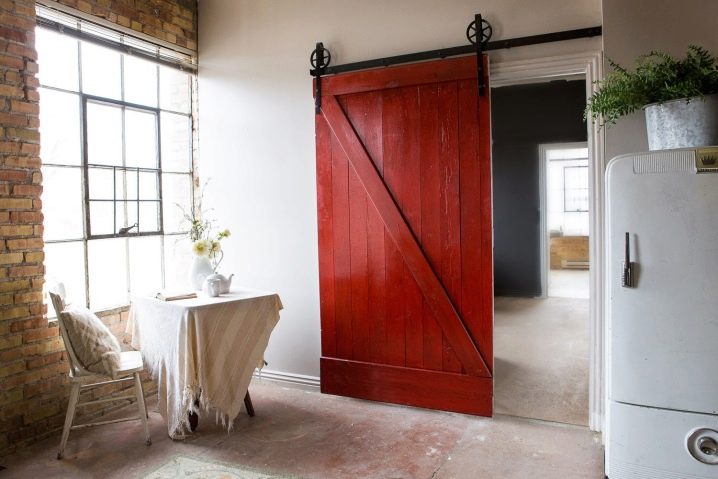
What it is?
Barn doors are usually used in household and utility buildings:
- sheds and home workshops;
- orphanages;
- baths.
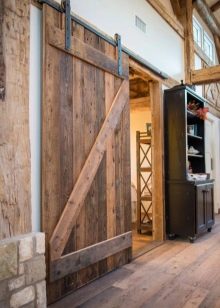
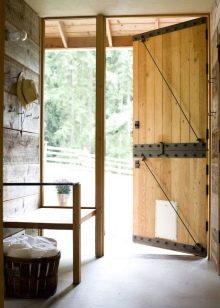
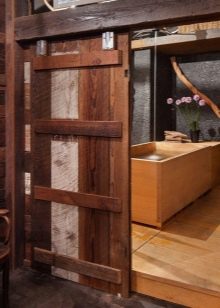
Their advantage is quite obvious: even though everything is swept from the outside by deep snowdrifts, it is not difficult to open the door. But in an urban dwelling, such structures can well be used, primarily for aesthetic reasons. An entrance block made of solid wood, placed on metal rails, often turns into the semantic center of the interior.
At the same time, barn doors save space, and even despite the occupation of an empty wall, they are ideal for small-sized dwellings.
There is nothing strange in that - the canvas simply drives into a prepared pencil case, and does not interfere with people. Experts recommend installing a barn door in the aisle from the kitchen to the living room, as it provides high traffic.
Important: by installing it in the bedroom, you can easily place the bed at the very entrance. If desired, options are available with sliding mechanisms from several canvases at the same time, folding to one side of the opening.
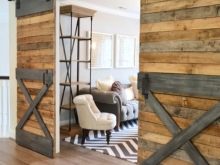


In any case, the barn door is outwardly catchy and expressive. For the manufacture of her canvases, not only wood mass is used, but also glass, plastic, even metal.
Design options
Familiar wooden structures fit perfectly into rooms decorated in the following styles:
- classicism;
- provence;
- country;
- loft.
They are also applicable in vintage, rustic, even industrial style - but on condition that the design is approached in good faith and thought out deeply.
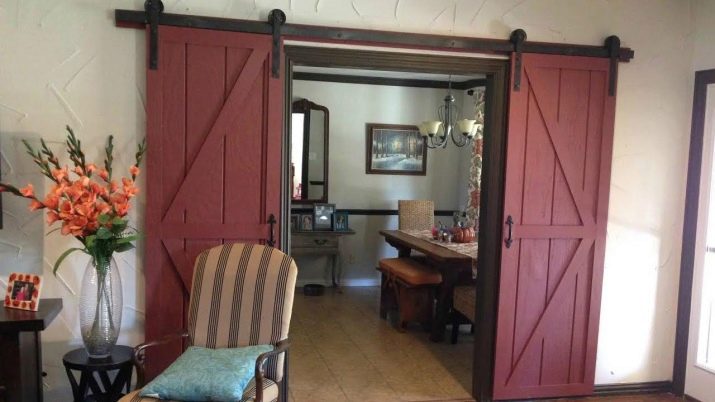
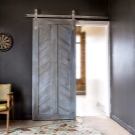
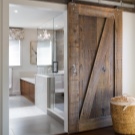
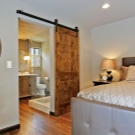
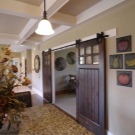
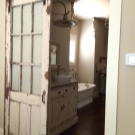
If the interior is rustic, the door must be equipped with heavy cast iron rollers.
But in modernist rooms, chrome options will be much more appropriate.
Country and Provence work best with raw array input constructs. When there is a desire to make the atmosphere even more interesting and richer, they use the original door, really used in the barn, or at least stylized antique.
Imitations of wooden beams and fake fireplaces can complement the impression.
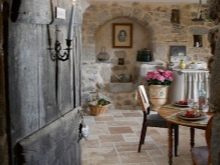
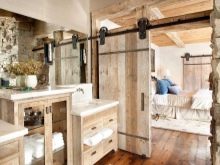
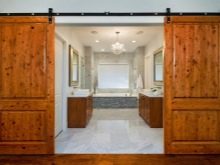
Important: the barn door can also be made in a compartment format. This approach first appeared in the United States, but designers from other countries also appreciated it pretty quickly. Outwardly, the structure appears as an ordinary old door; it is stylistically permissible to place it in any interior. Such solutions are most often used in loft-style rooms or in a "rustic" environment.
The simplest option - just hammered boards - looks like the most authentic. However, there are also more spectacular varieties, this one and one very wide board with a beautiful structure, and exclusive doors.
The barn door in the living room, becoming a composite core, will help to make the texture of modern interiors more diverse. With its help, you can visually "hide" a bar, TV or something else.


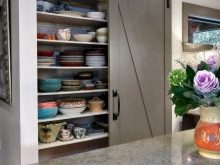
Attention: the barn door installed in the living room should not be used for its intended purpose, its role is purely decorative in this case. Black and gray canvases look good in the apartment; this option is considered universal.
Glass panels or frames are good alternatives to a simple wooden door. By applying rich colors - yellow, green, and if you want, orange, it will turn out to further enhance the concentration of attention on the door.



Let's clarify that bright colors will look better and more appropriate if they are duplicated somewhere else as an accent or decoration color.
Manufacturing
The very first step is to frame the boards; tapered boards with a width of 25 cm are preferred for frame structures.
According to the majority of craftsmen, you need to connect the boards with the "half-tree" technique. Its essence is simple, a cut is made at one end, which allows you to connect the element to the other board.
After making a few cuts at half thickness in the right place, using a hammer and a wide chisel, remove the wood and trim the joint. Having assembled a ready-made kit, you can immediately install it, hang the lock, and so on.

The manufacture of a door always implies the selection of material: home craftsmen have the right to use both coniferous and deciduous wood.
The final choice depends on:
- financial capabilities;
- available tools;
- external or internal placement of doors;
- using them in a room with normal or increased humidity.

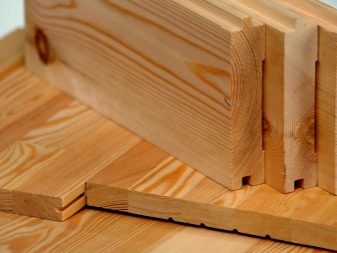
Oak wood is beautiful and durable, but it is difficult to process it, and the cost is not the most sparing. It is more correct to use it, as well as the beech wood, at the entrance to the house. It is better to cover interior structures with a canvas made of simpler types of wood - pine, birch, spruce.
The barn door is almost always assembled from parallel boards held by planks running perpendicularly or diagonally.
Take the selection of fasteners very seriously. Any nail must firmly fix the board, the bar, but not go through. After the blank of the structure is knocked together, it is tried on at the desired opening, and the excess is cut off.

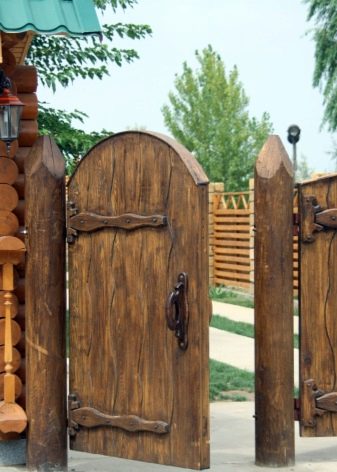
Mechanism
The barn door can be with or without glass, decorated with various decorative elements, or represent only a simple hanging canvas. None of this makes any sense unless a well thought out and smooth running mechanism is provided.
The top track is executed in various geometric shapes:
- circle;
- hexagon;
- Latin letter J;
- rectangle.
The door moves, leaning on rollers fixed either on the upper end or on the upper outer part (special plates are used for this).


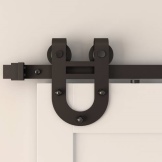

The upper track is equipped with side stops, which sometimes act as dampers. The lower guide brackets in the shape of the letter P, which are made slightly wider than the canvas itself, help to avoid jerking the hanging door to the side. Another version of them is a block in the shape of the letter T, which fits into a groove in the canvas itself.
Mounting
Making barn-type doors is only part of the problem, they still need to be installed by hanging them from the rail. When opening and closing, the canvas moves with the help of carriages, rollers. The rail mount is loved by designers because it can withstand more stress than hinges. This property is useful when filling very wide openings or when zoning a space with a partition door.
There is no lock in most cases, although you can install one if you want more privacy.
How to install a barn door, see the next video.
Interior use
According to experts, it is most correct to use the barn door on the aisle to the kitchen.
Barn doors are often multifunctional: they close the passage and hide at the same time, for example:
- office in the house;
- pantry;
- home library;
- workshop or household block, and much more.
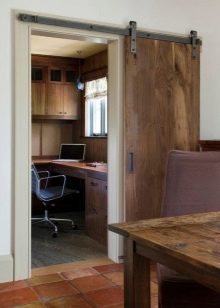
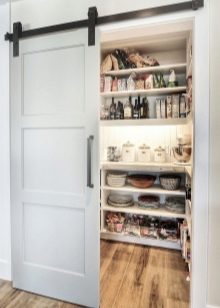
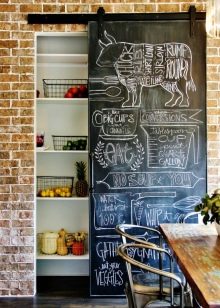
Before buying or making a barn door, you need to thoroughly figure out whether you need it. Do not rush to remove the previous door, first look at what kind of jamb is used there.
Often there is a situation where even a parallel distribution of mass on the upper horizontal support does not help to achieve the desired stability. In a modern home, there is almost no reason to be afraid, but in old buildings, especially where arched doors were installed, everything needs to be thoroughly checked.
It is especially important: in no case should the barn entrance structure be fastened to drywall guides, they may not cope, and then sometimes the whole wall collapses.


Do not forget that such doors, even if they completely cover the opening, do not always adhere tightly to it. Only products that do not deviate from the wall should be placed in the bathroom. Please note that the gap between it and the canvas sometimes makes it difficult to mount the skirting board.
Barn doors look good in a wide variety of styles and are quite reliable. But their choice (or self-production), installation and use have many nuances. Paying timely attention to these points, you will avoid a lot of problems and will be completely satisfied.
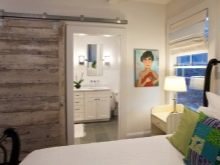
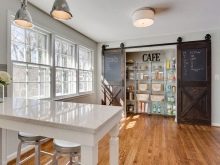
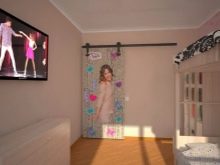













The comment was sent successfully.